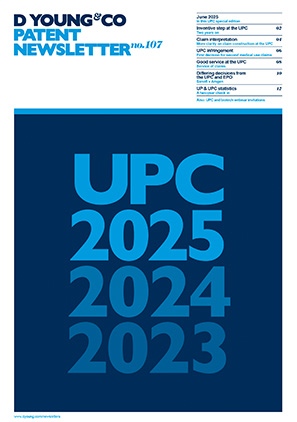SPC eligibility for combination products: clarification at last?
The Court of Justice of the European Union (CJEU) has issued its long-awaited judgment on how Articles 3(a) and 3(c) of the EU Supplementary Protection Certificate (SPC) Regulation are to be interpreted in the joined cases C-119/22 and C-149/22.
Legal background
This case relates to the interpretation of Articles 3(a) and (c) of the EU SPC Regulation, which set two of the criteria for SPC protection in the EU. Article 3(a) requires that the product is protected by a basic patent in force; and Article 3(c) that the product has not already been the subject of an SPC.
Prior CJEU case law has provided some guidance on interpretation of these provisions. Three possible tests for compliance with Article 3(a) have been considered by the courts:
- The “infringement” test: wherein it is sufficient that the approved product falls within the claims of the basic patent.
- The “specifically identifiable” test: wherein the approved product must not only fall within the claims of the basic patent, but be sufficiently identifiable (preferably expressly, as a specific compound) within the claims and/or description of the basic patent.
- The “inventive advance”(or “falls under the invention” test): wherein the approved product must also reflect the inventive contribution made by the patent.
Related article
See our related article “Can we finally advance? CJEU asked once again to consider SPC eligibility of patents for combination products”, 14 March 2022.
Clarification as to which test or tests is applicable for the assessment of Article 3(a) to combination SPCs has been long overdue. The CJEU’s decision in these joined cases appears to provide some much-needed clarity in this regard, by indicating that both tests 2 and 3 are applicable.
Case C 149/22
In brief, based on EP1412357, Merck was granted a first SPC in Ireland to a medicinal product comprising ezetimibe as the sole active ingredient. Subsequently, Merck obtained a second SPC based on the same basic patent, granted to a medicinal product comprising a combination of ezetimibe and simvastatin.
During infringement proceedings, the Irish courts relied on test 3 (the inventive advance or falls under the invention test) and held that the combination of ezetimibe and simvastatin did not “fall under the invention” of the basic patent and thus did not meet the requirements of both Articles 3(a) and 3(c). This decision was appealed by Merck, which submitted that test 3 is only relevant if the basic patent fails to expressly mention the product in question (if test 2 is not met). Merck also highlighted that test 3 was no longer relevant since it was rejected by the CJEU in C-650/17 (Royalty Pharma Collection Trust v DPMA).
Case C 119/22
The issues in C-119/22 are largely aligned with those in C-149/22. In short, based on EP1412357, Merck was granted a first SPC in Finland to a medicinal product comprising sitagliptin as the sole active ingredient. Subsequently, Merck obtained a second SPC based on the same basic patent, to a medicinal product comprising the combination of sitagliptin and metformin.
Teva sought to invalidate the second combination SPC on the grounds that the first SPC to sitagliptin precluded grant of the second combination SPC, contrary to Article 3(c), and that the combination was not protected by the basic patent, contrary to Article 3(a).
Questions referred
In view of the uncertainty in the current case law, specifically regarding the applicable tests for the assessment of Articles 3(a) and 3(c), the questions referred by the Irish and Finnish courts largely addressed the same points. These were essentially combined by the CJEU in its decision, which ruled on the following three questions.
1. Does Article 3(c) preclude the grant of an SPC for a product consisting of two active ingredients where one of those active ingredients has already been the subject of an earlier SPC as a sole active ingredient (the second active ingredient being already known at the filing or priority date of the patent)?
In answer to this question, the court concluded that an SPC application to a product consisting of active ingredients A+B cannot be refused under Article 3(c) on the ground that a product consisting of only A or B has already been the subject of an SPC. The court confirmed that the combination A+B represents a different product to that consisting of only one of A or B.
In answering this question, the CJEU also clarified whether Articles 3(a) and 3(c) are to be considered in light of each other or independently. In this regard, the CJEU highlighted that Article 3(a) seeks to delimit the scope of the SPC by reference to the basic patent, whereas Article 3(c) seeks to limit the temporal scope of the supplementary protection conferred on a given product.
From this, the CJEU clarified that the conditions laid down in Article 3(a) cannot be regarded as being relevant for the purpose of interpreting Article 3(c), and that the content of the basic patent is therefore irrelevant in the context of Article 3(c).
2. Must Article 3(a) be interpreted as meaning that it suffices that a product is expressly mentioned in the claims of the basic patent in order for that product to be protected by that patent?
This question raises the issue of which test is applicable for the assessment of Article 3(a) and specifically, whether test 2 is sufficient or whether a combination of tests 2 and 3 is required.
Related article
This is as presented in the two-step test provided for in the Teva judgment. For more information see our related article “CJEU thickens the fog on SPC eligibility”, 26 July 2018 (C-121/17, Teva and others v Gilead).
The CJEU confirmed that in order for a product to be “protected by a basic patent’, it is always necessary that the product “fall under the invention” protected by that patent. As a result, the CJEU confirmed that test 3 is relevant, regardless of whether the product is expressly mentioned in the basic patent.
The CJEU noted that if the mere mention of a product in the claims of a basic patent were to suffice, without the patent disclosing how that product constitutes a technical feature required for the solution of the technical problem disclosed by that patent, an SPC could be obtained for a product which is not the result of the research leading to the invention protected by the basic patent. This was considered contrary to the intended objective of the SPC Regulation, which is to encourage pharmaceutical research. Such an objective-based (teleological) interpretation is commonly used by the CJEU to interpret EU law, including on SPCs, even if it conflicts with the literal wording of the legislation.
3. Must Article 3(a) be interpreted as meaning that a product consisting of A+B is protected by a basic patent where A and B are expressly mentioned in the claims of that patent and the patent teaches that A may be used as a medicinal product for human use alone or in combination with B which is an active ingredient in the public domain at the effective date of that patent?
This question acts to align the CJEU’s comments provided for question 2 to the situation of combination products. The CJEU confirmed that for a product consisting of two active ingredients (A+B) expressly mentioned in the claims of the basic patent to meet the requirements of Article 3(a), that product must necessarily “fall under the invention” covered by that patent. The CJEU thus clarified that the express mention of the two active ingredients comprising the product at issue is insufficient for that product to be compliant with Article 3(a).
Interestingly, the CJEU indicated that if the basic patent discloses that the combination of the two active ingredients provides a synergistic effect contributing to the solution of the technical problem, it may be concluded that the combination product necessarily falls under the invention covered by that patent.
Implications
The CJEU’s decision will have wide-ranging implications for SPC cases involving combination products. In particular, the decision acts to confirm that an assessment of whether a combination product “falls under the invention” of the basic patent is required in all situations when considering Article 3(a). The CJEU relied on this language from the Teva judgment, rather than the “core inventive advance” language of the Actavis I decision.
The CJEU’s decision seemingly places a higher bar for the assessment of Article 3(a) for combination products, suggesting that if a basic patent discloses both single active ingredients and combinations, the combinations must themselves “fall under the invention” and must be necessary for solving the technical problem. As a result, the common practice of simply listing combinations in a patent is unlikely to be sufficient for the requirements of Article 3(a).
Nevertheless, how to assess whether a combination “falls under the invention” of the patent remains somewhat unclear. Whilst the decision of the CJEU suggests that a synergistic effect between two active ingredients would justify an SPC, it is not clear whether this will be essential. However, the implication that some form of data directed to the combination may be required suggests that delaying the disclosure of combinations within patent filings may be appropriate until data supporting a technical effect for that combination has been established. This is particularly since the CJEU’s decision is silent on whether the evidence supporting the combination must be present at the time of filing or whether post-filing data can be taken into account.
We look forward to seeing how the referring courts implement the CJEU’s decision in the context of assessing Article 3(a). The D Young & Co SPC team would be pleased to answer any queries you have on this decision.
Related articles
- “Can we finally advance? CJEU asked once again to consider SPC eligibility of patents for combination products”, 14 March 2022: dycip.com/spc-irish-supreme-court-questions
- “CJEU thickens the fog on SPC eligibility”, 26 July 2018 (C-121/17, Teva and others v Gilead):
dycip.com/c121-17

